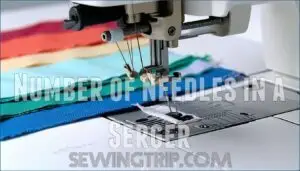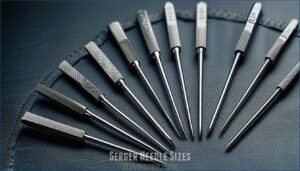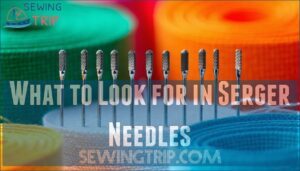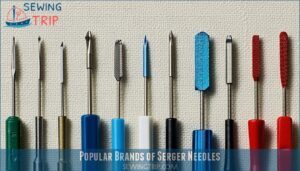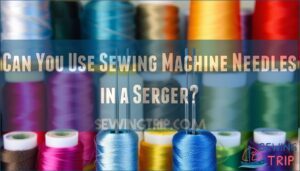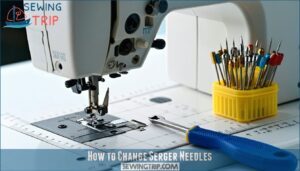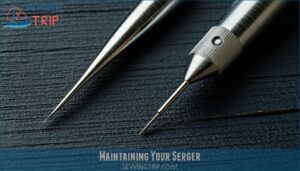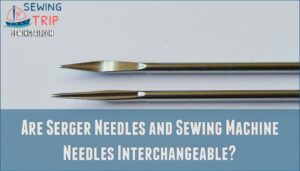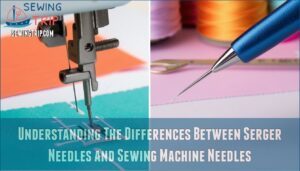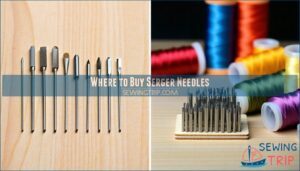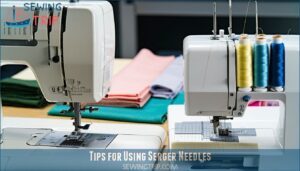This site is supported by our readers. We may earn a commission, at no cost to you, if you purchase through links.
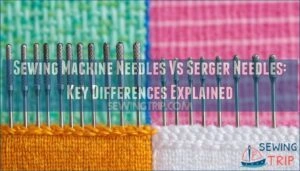 When comparing sewing machine needles vs serger needles, the difference lies in their design and purpose.
When comparing sewing machine needles vs serger needles, the difference lies in their design and purpose.
Sewing machine needles fit most standard machines and handle a single thread line, perfect for basic stitching.
Serger needles, on the other hand, are built for overlock machines, which need two or more threads to create durable seams and edges.
Sergers often require specific needle types, like ELx705, to handle their speed and precision.
While some sergers accept sewing machine needles, it’s risky and can impact stitch quality.
Choosing the right needle guarantees smooth sewing—because skipping details here can unravel your whole project, literally, and this is why it is crucial to understand the difference between sewing machine needles.
Table Of Contents
- Key Takeaways
- Understanding Needle Anatomy
- What Are Serger Needles and How Do They Differ From Sewing Machine Needles?
- Can You Use Sewing Machine Needles in a Serger?
- How to Change Serger Needles
- Maintaining Your Serger
- Are Serger Needles and Sewing Machine Needles Interchangeable?
- Understanding The Differences Between Serger Needles and Sewing Machine Needles
- Where to Buy Serger Needles
- Tips for Using Serger Needles
- Frequently Asked Questions (FAQs)
- Conclusion
Key Takeaways
- Don’t use sewing machine needles in a serger unless the manual explicitly allows it—mismatched needles cause skipped stitches and tension issues.
- Always match needle size and type to your fabric and thread for smooth seams and proper stitch quality.
- Replace serger needles every 8-10 hours of sewing or after each project to avoid dull needles causing uneven stitches.
- Check your serger manual for compatible needle types and follow alignment instructions to keep your machine running smoothly.
Understanding Needle Anatomy
Understanding needle anatomy is key to smooth stitching.
A needle shank guarantees proper fit in your machine—serger needles often have round shanks, while sewing machine needles include one flat side.
The needle shaft holds a groove to guide thread, while the needle blade determines size, ranging from 60-100 for various fabrics.
The scarf function—like a handshake with the bobbin—allows seamless thread grabbing.
Serger grooves near the eye make threading multiple paths easier, offering precision over sewing machine needles’ simpler design.
To guarantee the best results, match needle size to fabric.
What Are Serger Needles and How Do They Differ From Sewing Machine Needles?
Serger needles are designed to handle the high-speed stitching and multiple threads used in serger machines, making them unique compared to regular sewing machine needles.
Built for speed and precision, serger needles master multiple threads effortlessly, creating durable and flawless seams on any project.
They’re shorter, often have specific grooves, and can accommodate more complex stitching paths for creating precise and durable seams.
Number of Needles in a Serger
Your serger isn’t just a sewing machine on steroids—it’s got its quirks, starting with needle configuration. Most sergers use two needles, though some models step it up with three or four, adding versatility to stitch formation. Those extra needles pair with the looper interaction to handle complex designs efficiently.
Here’s what you need to know:
- Two-needle setups are standard, offering strong seams and balanced thread tension.
- Three or four needles widen your options, great for decorative stitching or differential feed adjustments.
- Always stick to serger-specific needle types to avoid damage or irregular stitches.
Check your serger machine manual for compatible needle systems—it’s your sewing Bible! Remember to understand the importance of needle configuration and using the right needles for your serger to ensure strong seams and efficient stitching.
Serger Needle Sizes
No need to overthink serger needle sizes—they’re easier than they sound! These sizes, ranging from 60/8 to 120/19, help you match needle thickness to fabric load.
Smaller sizes like 65/9 work great for lightweight fabrics, while 90/14 handles heavier materials like canvas effortlessly. Each size pairs with specific tasks, so always check your serger manual for recommendations.
Brands like Schmetz and Klasse even simplify needle coding for clarity. You can find various needle products online.
Remember, using sharp serger needles suited to fabric thickness keeps stitches smooth and your projects looking polished!
What to Look for in Serger Needles
Picking the right serger needles can feel like finding the perfect puzzle piece for your machine. Start by checking Groove Specifications—serger needles have a short groove near the eye, helping manage multiple thread pathways.
Look at the Shank Type; most have unique shapes designed for certain needle systems, ensuring compatibility. Always match Needle Point Shape to your fabric—medium ballpoints work well for knits, while sharper points suit woven materials.
Needle Selection is simpler when Needle Sizes, typically ranging from 60 to 100, match your fabric and thread. Understanding available needle options can also simplify the selection process.
Material Composition matters too—reinforced blades last longer. Finally, keep an eye out for a recognizable Brand Comparison stamp for easy replacements later. It’s all about the details.
Popular Brands of Serger Needles
When choosing serger needles, it’s smart to focus on trusted brands that deliver quality and reliability.
Schmetz ELx705 needles are a go-to option with reinforced blades that enhance durability. Singer needles, particularly their Universal, Ball Point, and Chromium lines, cater to various fabric types.
Klasse Type G needles are a versatile choice, covering most serger models effectively. Organ needles, favored by many, also offer excellent options for industrial use.
Your serger’s manual might recommend specific needle types, but experimenting within trusted needle brands like Schmetz, Singer, Klasse, and Organ guarantees high-quality results.
Regular replacement helps maintain optimal stitching performance, as seen in optimal stitching performance. With great needles, you’ll avoid headaches like skipped stitches!
Can You Use Sewing Machine Needles in a Serger?
You might wonder if sewing machine needles can work in your serger, and the short answer is—it depends.
While some serger models accept them, using the wrong needle can lead to skipped stitches or even damage your machine.
Risks of Using Sewing Machine Needles in a Serger
Using sewing machine needles in a serger might sound convenient, but it’s a gamble for your projects.
Without the unique grooves and shorter shank of serger needles, you risk:
- Machine Damage: Incompatible needles can lead to costly repairs.
- Tension Problems and Stitch Quality: Uneven stitches and skipped threads ruin your finish.
- Safety Hazards: Needle breakage increases injury risks.
Stick with serger needle types for stress-free sewing.
Remember, good compatibility equals consistent stitches—and fewer headaches.
Always clean lint for peak performance!
Serger Models Compatible With Sewing Machine Needles
Not all serger models welcome sewing machine needles, but some newer serger models do.
Brands like Baby Lock and Janome offer serger compatibility with sewing machine needles, yet caution is key.
Always verify needle compatibility through your manual, as ignoring this can create tension issues or skipped stitches.
Manual wheel testing is a great way to guarantee safety before sewing.
Avoid mixing needle brands—uneven stitches often sneak in that way, and stick to manufacturer guidelines for happier stitching and fewer surprises, following the manufacturer guidelines.
How to Change Serger Needles
Swapping serger needles isn’t tricky if you focus on a few details.
Swapping serger needles is simple—stay focused, follow proper alignment, and ensure tight screws for stress-free, flawless stitching every time!
First, turn off the machine—safety matters.
Then, loosen the needle clamp screws using a hex wrench or pliers.
Remove the bent needle carefully, noting the correct needle insertion direction.
Always insert needles fully and make certain of proper serger needle alignment, as the right needle sits slightly lower.
Tighten the needle securely to avoid issues later.
A needle holder makes needle replacement smoother.
Keep spare needles organized for stress-free sewing.
Maintaining Your Serger
Maintaining your serger keeps it running like a charm.
Start by mastering lint removal—use a lint brush or cotton swabs to clear dust from tight spots.
Tension adjustments and oiling mechanisms are vital; oil your serger every three projects to avoid wear.
Don’t forget needle maintenance: replace or sharpen needles regularly and choose the right serger needle types and sizes for your fabric.
Annual professional servicing helps immensely and guarantees smooth performance.
Treat your serger right, and it’ll deliver flawless stitches.
To maintain peak performance, address any serger knife problems.
Are Serger Needles and Sewing Machine Needles Interchangeable?
Switching sewing machine needles for serger needles might sound tempting, but it’s a risky game.
Serger needles are built for multiple loops and high-speed stitching, while sewing machine needles focus on smoother basics.
Compatibility depends on your model, so check a Needle Compatibility Chart before experimenting.
Mismatched needles can affect stitch quality, create tension adjustment issues, or even damage your machine.
Always follow model-specific needle guidelines, double-check sizes, and take safety precautions.
Accuracy and the right needle types guarantee flawless results!
Understanding The Differences Between Serger Needles and Sewing Machine Needles
In regards to sewing machine needles and serger needles, they might look similar at first glance, but their differences are game-changers.
Sewing needles feature a single threading pathway, while serger needles are built to handle multiple threading pathways for intricate stitch formation. The needle groove design on sergers is shorter to accommodate rapid stitching.
Consider these key points in this needle comparison:
- Shank Variations: Most sewing machine needles have a flat-shank design, while serger needles can have rounder shanks, depending on the model.
- Point Differences: Sewing needles include universal or ball-point tips, but serger needles often have sharper points to pierce fabrics with precision.
- Threading Pathways: Sergers need needles with grooved shafts and unique codes like ELx705 for complex tasks.
Mastering these guarantees smoother sewing!
Where to Buy Serger Needles
Finding quality serger needles is easy with these options:
- Online Retailers: Check stores like Walmart.com or Arts, Crafts & Sewing Store for a wide needle variety, including bulk buying deals.
- Local Stores: Specialty sewing shops often carry top needle brands like Schmetz, Singer, or Klasse, with staff available to guide you.
- Brand Websites: Visit manufacturers like Schmetz or Janome for direct access to their needle collections.
Many sites offer options to serger needles buy. Explore trusted serger needle brands for durability, compatibility, and performance on every project!
Tips for Using Serger Needles
Using serger needles effectively is key to seamless projects.
Follow these tips for success:
- Match the thread to your fabric for smooth stitching and better finishes.
- Select the right needle size—lighter fabrics need smaller needles, while heavier ones require larger sizes.
- Use your serger’s needle guide to avoid mismatched needles, which can cause tension issues.
- Test stitch tension and differential feed on scrap fabric to stabilize seams and prevent puckering.
These simple steps help every serger project shine with ease!
Frequently Asked Questions (FAQs)
How Often Should I Replace My Serger Needles?
Replace your serger needles after every 8-10 hours of use or every project, whichever comes first.
Dull needles can cause skipped stitches or uneven seams, so don’t skimp—fresh needles keep your stitches sharp and smooth!
Are There Any Special Techniques for Using Serger Needles?
Always test serger needle alignment by turning the handwheel first.
Match needle type to your fabric, adjust the tension properly, and replace needles regularly to avoid skipped stitches or uneven seams.
It’s easier than fixing mistakes, especially when you follow these steps to ensure proper alignment and avoid common issues.
Are Schmetz Needles Compatible With All Serger Models?
One size doesn’t fit all.
Schmetz needles work with most serger models but not all.
Always check your serger’s manual for compatibility, as some models require specific needle types to prevent skipped stitches or tension issues.
Is It Possible to Buy Serger Needles in Bulk?
You can absolutely buy serger needles in bulk!
It’s a great way to save money and guarantee you’re always ready for your next project.
Just double-check compatibility with your serger model before purchasing!
Are There Any Special Tools Needed to Change Serger Needles?
Changing serger needles is a piece of cake—you’ll just need a small screwdriver, often included with your machine.
It helps loosen the needle clamp screw, making removal and replacement straightforward and hassle-free.
Can I use sewing machine needles in a serger?
You can sometimes use sewing machine needles in a serger, but it depends on the serger model.
Check your manual first.
Using the wrong needle might cause skipped stitches, tension issues, or damage.
Can I use sewing machine needles in an overlocker?
You can sometimes use sewing machine needles in an overlocker, but it depends on the machine.
Check your manual first—using the wrong needle can lead to skipped stitches, tension issues, or even machine damage.
Are serger needles different heights?
Yes, serger needles can have different heights depending on the brand or model.
This variation guarantees proper alignment with the machine’s loopers, so always check your manual to avoid stitching issues, particularly to ensure proper alignment.
How often should I replace my serger needles?
Switch serger needles smoothly and systematically every 8-10 hours of sewing or after finishing 8-10 garments.
Dull needles can cause skipped stitches, so don’t let your threads suffer—keep them fresh and sharp!
Are there any special techniques for using serger needles?
Always thread serger needles with precision, ensuring proper groove alignment.
Test stitches on scrap fabric before starting your project.
Replace both needles together for balance, and don’t force needles—manual wheel testing helps avoid costly mistakes, using this technique will ensure proper alignment and function.
Conclusion
They say, "A stitch in time saves nine," and choosing the right needle—whether sewing machine or serger—proves it true.
Understanding the differences between sewing machine needles vs serger needles isn’t just about compatibility; it’s about preserving stitch quality and your project’s durability.
Use serger-specific needles for overlocking efficiency, and avoid shortcuts that risk skipped stitches or threading mishaps.
By matching the needle to the machine, you’ll sew smoothly, avoiding potential frustration and ensuring professional results every time, with a focus on achieving the best possible sewing machine performance.

